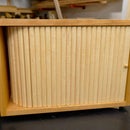Introduction: Easy Half Lap Joints
If you’ve ever tried to cut a half lap joint and been frustrated with the results, welcome to the club. Up until now my lap joints were pretty much hit and miss. Sometimes perfectly flush, other times loose or cut too deep. I grew tired of the inconsistency and decided there must be a better way!
After extensively looking into the methods others have used, I’ve come up with a fail proof method that will allow you to cut accurate and consistent half lap joints every single time. The best part: You don’t need a dado stack or any elaborate jigs.
Step 1: Tools
For this method, you’ll need the following tools:
- Table saw
- Crosscut Sled
- Combination Square
- Quick-grip clamp
- Spacer with the exact same thickness as your saw blade - I'll show you how to make your own spacer
Step 2: Make a Custom Spacer
The secret to this method is so simple yet extremely effective. The key is to make a custom spacer that is the exact same thickness as your table saw blade. Many blades are 1/8” so you could easily use some 1/8 plywood. For thin kerf blades, you’ll need to make a spacer to spec.
Find a small piece of wood, like a 1x2. Using your crosscut sled, start by squaring off the end, then slice off a tiny piece roughly 1/8” thick.
Remove the crosscut sled, and raise your saw blade. Place a piece of scrap birch plywood on each side of the blade (like a saw blade sandwich). Try to fit the spacer into the sandwich (spoiler: it likely won’t fit). Lay some sandpaper on a flat surface and sand the faces down until the spacer fits between the plywood boards.
Make sure you mark this spacer KEEP! so you don’t accidentally throw it out.
Step 3: Find Half the Thickness
The first step to cutting a half lap joint is finding the exact mid-point between the top and bottom of your board.
While you can certainly measure the thickness and divide by half, this can sometimes be impractical and lead to slight error. An easier method is using a combination square. Set it to roughly half the thickness of the board. Trace a line from the top and then switch to the bottom. Adjust the combination square until both lines are on top of each other. You’ve found dead center.
Step 4: Adjust Your Blade Height
With your crosscut sled in place, slowly raise the blade until it creeps up close to the line, but still beneath it. It’s better to progressively adjust upwards, rather than to cut too deep on the first pass.
Using a scrap piece of wood with the same dimensions as your workpiece. Shave off one end, then flip the piece over and repeat. You should be left with a thin shaving between the two cuts. Gently raise the blade and repeat the cuts. Adjust progressively as needed until the shaving is fully sliced off.
Step 5: How to Cut Corner Half Lap Joints
To cut half lap joints at the end of 2 boards, let’s say to make a frame, follow this method:
- Lay one of the workpieces (A) up against the saw blade
- Butt a stop block up to this piece and clamp it down to the crosscut sled
- Remove workpiece A
- Place your spacer up against the stop block
- Butt the other workpiece (B) up against the spacer
- Make the cut
- Remove the spacer
- Make repeated cuts between the initial cut up until the end of the workpiece
- Repeat the steps for the second workpiece (A)
Step 6: How to Cut Midway Half Lap Joints
You can also use this method to cut half lap joints anywhere along the workpiece, whether it be in the center or 1 inch from the end. Simply mark where you want the joint to be and use that as a reference line for your first cut. Then follow these steps.
Tip: watch the video to see it step-by-step.
- Position your workpiece (A) on the crosscut sled and line up the mark you made with the right side of the sled’s kerf line
- Butt the second workpiece (B) (or a small scrap with the same exact dimensions) perpendicularly up against the workpiece, to the right
- Butt a stop block up to this piece, again to the right, and clamp it down to the crosscut sled
- Make the first cut.
- Remove workpiece B
- Place your spacer up against the stop block
- Butt your workpiece (A) up against the spacer
- Make the cut
- Remove the spacer
- Make repeated cuts between the 2 cuts you made above
- Repeat the steps for the second workpiece (B)
Step 7: Final Adjustments
After making the cuts, you may find that the fit isn’t 100% perfect. Simply use some sandpaper to even out the bottom of the joint and remove the bumps caused by making multiple passes with the saw blade. Test again and you will find a perfect fit.
Be sure to check out the video tutorial if you haven't already done so. Please subscribe to my YouTube channel for more DIY video content.
You'll also find more projects on my website at diymontreal.com projects like:




